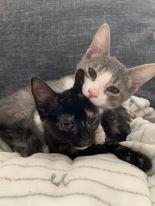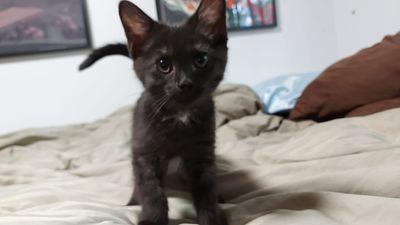From https://coleandmarmalade.com/
For a cat that’s living the lonely shelter life, the odds are already against them. But for a cat that’s living the shelter life with an illness, the odds are even higher that they’ll ever find a furever home. Many cat owners are familiar with FIV and FeLV, but not all know the differences between the two. For starters, FIV and FeLV are not the same thing.
FIV stands for Feline Immunodeficiency Virus; FeLV is the Feline Leukemia Virus. These two viruses are commonly confused because they are both retroviruses that can infect felines.
In humans, the most well-known retrovirus is HIV, Human Immunodeficiency Virus. While there are several different types of retroviruses known to man, they have different symptoms and ramifications that affect the infected individuals in a unique way. The different effects are felt on the organisms they infect, but no two retroviruses are identical in how the body deals with them.


FIV and FeLV are in the same family (Retroviridae), but are different types of retroviruses. FIV is a lentivirus and FeLV is a gamma-retrovirus. They can be thought of as distant cousins in the family tree of retroviruses. It is because of this that the symptoms and progression of the two diseases are quite different.
The first major difference is that FIV is a lentivirus. This means that it has an extended incubation period and can lay dormant with suppressed symptoms for many years. While it does affect a cat’s general health, it is most certainly not an immediate death sentence. Many cats living with FIV have a good quality of life, are affectionate, curious, playful and wonderful cats
FIV is a slow moving retrovirus. While it does attack they body, it’s more of a marathon spread than a quick sprint, to put it in casual terms. Most cats with FIV lead normal, healthy lives and show no symptoms for many years (if at all). When a cat with FIV crosses the rainbow bridge, it is generally due to complications of another illness. Their immune systems are suppressed and caused them to be more susceptible to secondary illnesses.
When it comes to FeLV, this is what is called a gamma-virus, and while also a retrovirus, it is far removed from FIV.
Cats with FeLV can have a variety of illnesses, ranging from anemia to leukemia and other cancers (or they may show no symptoms at all for many years – it just depends on the strain of the virus and how well the cat’s immune system reacts to it)
With FeLV, it moves through a cat’s immune system at a much faster rate than FIV, but many cats can still life for several months to years once contracting the virus. It is not as contagious as some might think, and it is most commonly spread from wounds, bites, and prolonged contact with an infected feline. It is less likely to spread from shared food/water bowls and litter boxes, but there is still the slim chance that this could be a possibility for felines sharing close quarters with FeLV infected felines.
Thankfully for us concerned cat owners, there is a FeLV vaccine that has proven itself highly effective from this deadly virus. (Cats are routinely given this vaccine as early as 8-12 weeks of age, so chances are your cat received this as a kitten should you have gotten them from a rescue/shelter.)
For cats that have been properly vaccinated, the chances of them contracting the disease from an infected cat is highly unlikely. Therefore, keeping a cat in your home that is vaccinated, and giving a FeLV cat a chance to live out their final months or years in a loving forever home is something that you may consider without worrying that you’ll be putting your cat’s health at risk.
Some might think that close contact is how FIV is spread, but this is entirely untrue. For FIV to be transmitted to another cat, it is done so from a deep puncture wound that breaks the skin barrier. These are not the playful little nibbles that cats will exhibit during those fun little cat battles. They’re more the kind that a cat would do during an aggressive fight, i.e. a territory dispute.
For this reason, as well as the longevity of a cat’s life living with FIV, it’s crucial that they are kept indoors. A stress-free environment where the spread of disease can be contained and monitored.
Another less common way in which FIV is spread is from an FIV-infected mother cat to her kitten. But please know that FIV has NOT been found to spread through sharing food bowls and litter boxes, social grooming, sneezing and other casual modes of contact.
We hope that this information could help influence a cat lover to consider adopting a cat living with FIV or FeLV. They deserve to live out the rest of their days–however long that may be–in a loving home rather than a lonely shelter.
Do your part for cats in need living with FIV and FeLV! If you don’t have room to adopt another cat, help to advocate for them. Be sure everyone knows that they can have a voice and hopefully, a home.